Content:
- How to grow onions.
- Planting and growing onions and leeks.
- Secrets of growing shallots.
- Planting and growing onions - batun.
The onion family includes such common plants in our gardens as spring onions, onions, and shallots. They are grown to produce the first spring greens, rich in vitamins and phytoncides, as well as bulbs, which are used in preparing various dishes and canning.
Most onions are unpretentious crops, and even a novice gardener can grow a good harvest by following some simple rules.
It is not recommended to grow onions in one place for more than 2 years. The best predecessors for onions are cucumbers, cabbage, potatoes and legumes. In addition, you can plant onions and garlic after beets, zucchini, and squash. Bad predecessors are carrots and tomatoes.
Pests. The main pests of onion plants are onion flies. To combat them, dig up the ridges on which onions or garlic grew in the fall, treat the seed material with insecticides before planting, and warm the onion sets for 24 hours at a temperature of + 40-45 degrees. A good result is obtained by using ash or tobacco dust if you sprinkle them on the beds with onions, as well as watering the plants with a solution of water and table salt (200 g per bucket of water).
Major diseases. Of the diseases that affect onions, the greatest damage to the crop can be caused by neck rot, as well as downy mildew. For control and prevention, immediately after harvesting, it is recommended to dig up the soil and add slaked lime or ash to it. It is recommended to burn damaged plants.
How to grow onions
Onions are a ubiquitous crop, grown for their bulbs and for their feathers (i.e., greens). There are several varieties of onions, which differ in ripening time, bulb color and taste. A good harvest of this crop can be obtained several times a year: in spring and summer in the garden, in autumn and winter in greenhouses. A small amount of greenery can be grown even in an apartment on the windowsill.
Temperature regime. Onions are a completely cold-resistant crop; their seeds germinate well at + 3-5 degrees.And the optimal temperature for growing a plant is 23-25 ° C; hotter weather can negatively affect crop yields.
Planting methods
To obtain bulbs, plants are planted in the ground using seedlings and non-seedlings; onions can also be grown from sets.
Seedless cultivation. The easiest way to plant onions is without seedlings. Sow the seeds directly into the ground, burying them 1-1.5 cm into the soil (so that seedlings appear faster, pre-soak the seeds).
Onions can be harvested 23-24 weeks after planting, making this growing method only suitable for areas with mild climates where planting can be done in early spring. In the middle zone, when planted in open ground, onions may not have time to ripen, so in order to get a good harvest, use winter sowing or the seedling method.
Winter landing. Conduct pre-winter sowing after the onset of stable cold weather so that the onions do not have time to germinate. Prepare the beds in advance before the soil freezes. Sow the seeds in the furrows to a depth of 5-6 cm, sprinkle a 2-3 cm layer of humus on top.
Growing onions through seedlings. To obtain strong seedlings, sow the seeds in March in shallow boxes or special cassettes. Use for growing seedlings ready-made soil mixtures or fertile garden soil. After sowing, cover the boxes with film and maintain the temperature within 18-25 ° C; when the shoots appear, move the boxes to a cool place (10-12 ° C) so that the sprouts do not stretch.
After a week, you can increase the temperature by 6-8 °C. Remove the cover for several hours a day for ventilation. Water the onion seedlings after 2-3 days.You can feed it 1-2 times min. fertilizers (20 g of ammonium nitrate, 15 g of potassium chloride and 40 g of superphosphate per bucket of water).
Planting seedlings in open ground. Before planting seedlings in open ground, it is a good idea to harden them.
It is best to plant seedlings at a distance between rows of 10-12 cm, between plants in a row - 6 cm. To avoid damaging the roots of plants when planting, it is best to replant onions with a clod of earth. Before planting, water the soil in prepared beds thoroughly.
The easiest way to plant onions. A less troublesome way to grow onions in areas with temperate and cool climates is to plant sets (small onions grown from seeds). Plant in the first ten days of May, making holes with a scoop or stake and deepening the bulbs by about 1 cm (try not to cover the neck with soil). Plant the sets at a distance of 20-25 cm between rows and 5-10 cm between bulbs. It is convenient to use double-row tape planting at a distance of 20-35 cm between rows and 5-10 cm between bulbs.
In closed ground, when growing onions for feathers (for greens), use sets as planting material.
Preparing the soil for planting onions
A good harvest can only be obtained by planting in well-lit, sunny areas with rich soil. Onions do not tolerate stagnant moisture, so this crop works best in well-drained areas. The soil on them should not be clayey.
It is best to prepare an area for growing onions in the fall. Dig up the soil to the depth of a spade bayonet, remove weed roots, apply rotted manure and mineral fertilizers. In the spring, loosen the top layer of soil, then level everything with a rake.
How to water
During the formation and growth of leaves, onions should be watered regularly (in May - once a week, and in June - once every 10 days), between waterings, loosen the soil between the rows and carefully weed out the weeds. However, remember that ripening of the bulbs requires a completely different humidity regime, so stop watering completely 3-4 weeks before harvesting.
When growing onions for greens in protected soil, water the soil as it dries and loosen it in between waterings.
How to feed and fertilize onions
When growing onions in open ground, fertilize per 1 m2 according to the following scheme: in the fall, when preparing the soil, add 4 kg of compost and 100 g of potassium sulfate; in the spring before planting - 25 g of nitrogen fertilizers; after the formation of the first leaves - 20 g of nitrogen-phosphorus fertilizers, and 5-7 days after this, fertilize the plants with manure diluted in water (in a ratio of 1: 10) or bird droppings (in a ratio of 1: 20).
To get a good harvest, carry out another feeding during the formation of the bulbs: add phosphorus-potassium fertilizers at the rate of 15-25 g per 1 m2.
If you notice that the onion is growing slowly and its leaves have turned white, add a mixture of 200 g of mullein and 20 g of urea dissolved in a bucket of water. After 15 days, feed the plants with another nitrophoska solution.
Onions grown by sowing seeds (nigella) are fed for the first time in the phase of appearance of the fourth leaf with infusion of mullein (1:10) or chicken manure (1:20), consumption - a bucket of 3-4 square meters. m. Make grooves 6-8 cm deep between the rows, water them with fertilizer infusion and cover them with soil. After two weeks, a second feeding is carried out: a teaspoon of urea and potassium sulfate, 2 teaspoons of superphosphate per square meter. m.
When growing onions in open or closed ground, apply complex fertilizers (once every 10 days).
Planting and growing onions and leeks
Leeks are a relatively new crop in our country, found in gardens less often than other bulbous plants. This type of onion is more common in the southern regions (this is due to the rather long period from germination to harvest).
Leeks are grown to produce the thickened lower white part of the stem (this plant does not form bulbs); if desired, young green leaves can be used for food. The main conditions for obtaining a good harvest of this crop are the correct choice of planting site and timely application of fertilizers.
Temperature
To get a good harvest, the average temperature during the growing season should be 17-23 ° C, although in general the crop is cold-resistant and can withstand short-term frosts down to -7 ° C.
When growing leeks in seedlings, plant the seedlings in the ground when the soil warms up to +10 °C.
Planting onions and leeks
In the southern regions of our country, leeks can be grown by sowing in open ground; in regions with a cool climate, the seedling method of cultivation is recommended - in this case, you can get a harvest in the year of sowing (approximately 45-60 days from the moment the seedlings are planted in the beds) . The ripening period depends on the early ripening of the variety, on weather conditions and the fulfillment of agrotechnical requirements.
To obtain seedlings, it is recommended to plant seeds in late February or early March in window boxes or greenhouses. Ready-made soil mixtures for vegetables or fertile garden soil are suitable as soil.
To speed up the emergence of seedlings, first wet and germinate the seeds. Caring for seedlings is approximately the same as when growing onions: water the seedlings regularly. You can apply liquid complex fertilizers once. The optimal temperature for the growth of leek seedlings is 18-25 ° C before seed germination and 14-16 ° C after germination. If the temperature is higher and the lighting is insufficient, the seedlings will stretch out.
Plant seedlings in the ground at the end of April or beginning of May. Plant in furrows 10-15 cm deep (the distance between individual plants is at least 10 cm). After 2 weeks, fill the furrows with fertile soil.
The soil must be fertile and necessarily loose, preferably neutral. On acidic soils it will not be possible to get a good harvest of leeks.
How to water onions
Leeks are a moisture-loving plant, so do not forget to water them regularly from the moment the seedlings are planted until the end of the growing season, increasing the frequency of watering in the dry months. After each watering, loosen the rows.
Hilling onions
In order to grow juicy bleached stems and a high yield, hill up leeks 3-4 times a season. And of course, in addition to this, do not forget to pull out the weeds and loosen the soil.
Top dressing
Fertilize leeks regularly - without this you will not be able to get a good harvest. Nitrogen fertilizers are especially important for leeks - they are especially necessary in the second half of summer, when greenery is actively forming.
It is optimal to alternate liquid organic fertilizers, for example, an aqueous solution of mullein 1:8 or bird droppings 1:20 at the rate of 3 liters per 1 square meter. m.and mineral fertilizers (for example, a solution of ammonium nitrate and potassium sulfate at the rate of 15-20 g per 1 m2).
Planting and growing shallots
Shallots or family, multi-nest onions, are valued for their early ripening and taste. This species is less common than onions. Several small onions are formed in one nest, which have a less pungent taste than regular onions. Shallots can be grown in open ground for bulbs and feathers, and in closed ground for feathers. Shallot leaves do not become rough for a long time and remain juicy.
Temperature
Shallots tolerate low temperatures well. If you leave it to winter, it can easily withstand soil freezing down to -20 degrees, and in the spring greenery will appear earlier than other types of onions. The optimal temperature for shallots during the growing season is 20-24 °C.
Planting shallots
The easiest way to propagate shallots is by vegetative method - by planting bulbs, and for growing new varieties, the seed propagation method is preferable.
Before planting, soak the bulbs for 20-30 minutes in a pale pink solution of potassium permanganate, and then rinse with cold water.
Plant in spring (from late April to early May) or autumn (from late September to early October). For spring planting, use medium-sized bulbs (3-4 cm in diameter); for autumn planting, use smaller ones (about 2 cm in diameter).
Plant the bulbs to a depth of 2-4 cm; when planting in autumn, mulch them with peat or soil with a layer of 3-4 cm.
The recommended planting pattern for shallots is a four-line ribbon. Leave a distance between ribbons of 70 cm, between lines - 20 cm, and between plants in a row - 10 cm.
To obtain large shallot bulbs, experienced gardeners suggest planting in the spring, planting the bulbs 15 cm apart from each other, and 30 cm between rows. During the growing process, periodically pull out one bulb from each nest (they can be used for food), so that by autumn There are 1-2 bulbs left in each nest.
When growing shallots for feathers in protected ground, plant them in the second half of February, then in the spring you will reap the first harvest of greens.
When forcing shallots into feathers, the bulbs can be reused. To do this, after cutting the greens, remove them from the soil, cut them crosswise and plant them again in boxes or pots with fertile soil mixture.
Tillage
When growing shallots in open ground in the spring, remove the covering material from the beds as early as possible so that the soil warms up faster. In this case, you will speed up the harvest of greens.
After emergence, loosen the soil in the rows and rows and thoroughly water the weeds.
It is recommended to loosen the row spacing 2-3 times during the summer to a depth of 5-6 cm; after each watering, it is enough to loosen the soil to a depth of 3-5 cm. During loosening, it is not recommended to add soil to the plants themselves, as this slows down the ripening of the bulbs.
If you are growing shallots in a greenhouse, loosen the soil not deeply, but after each watering.
Watering
In the first half of the growing season, water shallots regularly: from May to mid-July - 3-4 times a week; in hot and dry weather, you can increase the number of waterings. In the second half of summer, you need to water less, and you can stop watering 2-3 weeks before harvesting the bulbs.
In closed ground, water shallots regularly, but sparingly. Loosen after each watering.
How to feed shallots
During the entire growing season, it is recommended to feed the shallots 1-2 times (this is enough to obtain a rich harvest both in open and in closed ground). Use an aqueous solution of mullein (in a ratio of 1: 10), bird droppings (in a ratio of 1: 15) or complex min. fertilizers (at the rate of 20 g per 10 liters of water).
Planting and growing onions
Onion is a perennial plant; it can be grown both in open ground and in greenhouses. The plant can be successfully grown in one place for several years, but in the third year its yield decreases and the leaves become coarser.
There are several varieties of onion in cultivation, which can be divided into two main groups. Early-ripening semi-sharp ones produce a harvest in early spring, late-ripening acute ones ripen 30-40 days later. Growing spring onions is not difficult, especially if you plant varieties that are resistant to diseases.
Temperature
Onion is a winter-hardy crop; it tolerates frosts down to -45 °C. The optimal temperature for the growing season is 19-23 °C.
Sowing onions
Onion can be propagated by seedlings or without seedlings. Planting seeds in open ground begins at the end of April, to a depth of 2 cm. The easiest way is line sowing at a distance of 40-50 cm between rows, but you can also use a strip sowing scheme: sow seeds in 2-5 lines at a distance of 10 cm between in rows and the same amount between plants.
Onion - trumpet is easily propagated vegetatively. To do this, simply divide the bushes and plant each onion separately. It is best to do this in spring or late summer. Plant the bulbs in rows.
To get a good harvest, plant onions in spring, or at least in summer or early autumn.
For winter forcing in the fall, dig up several plants and transplant them into boxes, place them in a warm, bright place and water 2-3 times a week.
Getting an early onion harvest
To get early greenery, at the end of February - beginning of March, plant onions in tunnel-type film greenhouses. This method will allow you to get the harvest two or even three weeks earlier (and it will be 1.5-2 times higher than when growing onions in open ground).
You can also use a frameless shelter: sow onion seeds in open ground and cover with perforated film, sprinkling it with soil around the edges.
For forcing onions, onions can also be grown in a greenhouse. In the fall, plant the cuttings in rows, and already in March, when the onion leaves have grown by 15-20 cm, harvest the first harvest.
When growing onions in a greenhouse, make small furrows in the beds, plant the bulbs in them and cover them with soil. To get a good harvest, maintain a temperature in the greenhouse of +10-15 C, gradually increasing it to 20 C. The optimal air humidity is 70-80%. 7-10 days after planting, add mineral fertilizers to the soil.
Loosening
Loosening the rows is the key to getting a good onion harvest. A few days after the first weeding, loosen the soil between the rows of plants.
Watering
To get fresh, juicy greens, do not forget to water the onion (with a lack of moisture, its leaves become coarse and become bitter). The recommended rate is 3-4 times a week, 10-20 l/m2. 3-4 hours after watering, loosen the rows.
How to feed onions
To get a good harvest of onions, do not forget to feed them with mullein diluted in a ratio of 1: 8 or bird droppings (1: 20); one feeding per season is enough. After harvesting, it is advisable to apply liquid mineral fertilizers (50 g of ammonium nitrate, 3 g of superphosphate and 20 g of potassium chloride per 10 liters of water).
Author: L.S. Surkov agronomist
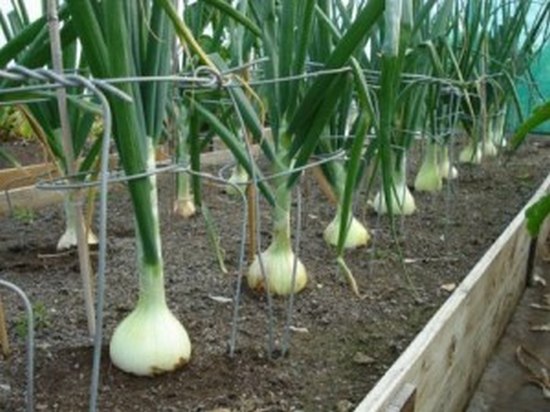
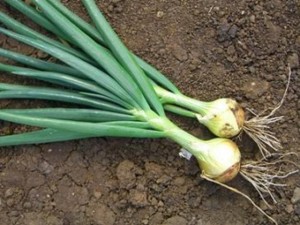
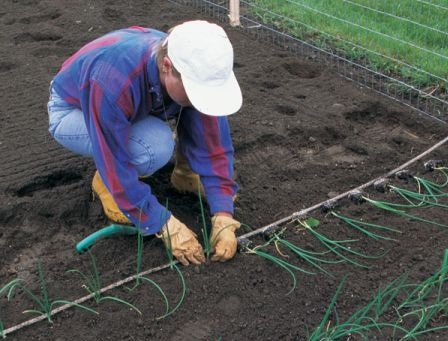
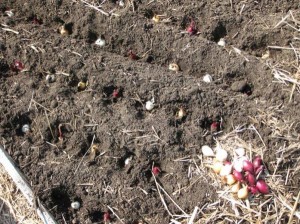
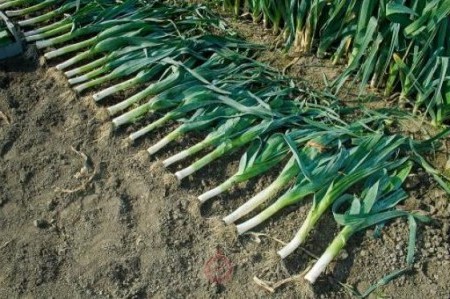
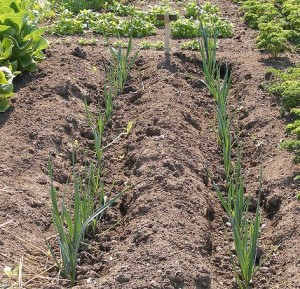
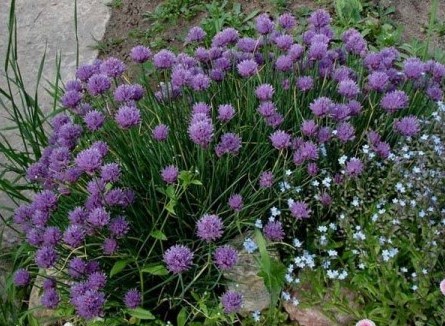
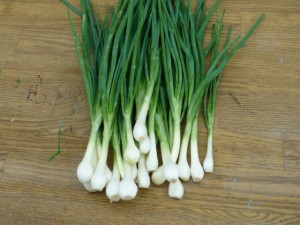
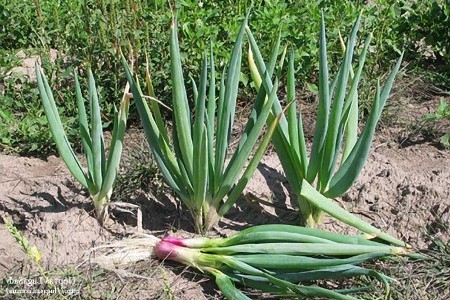
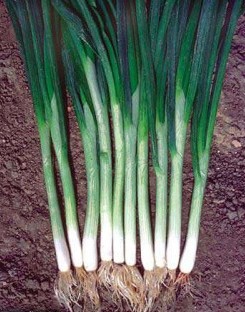

 (25 ratings, average: 4,16 out of 5)
(25 ratings, average: 4,16 out of 5) CUCUMBERS NEVER GET SICK, I'VE BEEN USING ONLY THIS FOR 40 YEARS! I SHARE A SECRET WITH YOU, CUCUMBERS ARE LIKE THE PICTURE!
CUCUMBERS NEVER GET SICK, I'VE BEEN USING ONLY THIS FOR 40 YEARS! I SHARE A SECRET WITH YOU, CUCUMBERS ARE LIKE THE PICTURE! You can dig a bucket of potatoes from each bush. Do you think these are fairy tales? Watch the video
You can dig a bucket of potatoes from each bush. Do you think these are fairy tales? Watch the video
 How our fellow gardeners work in Korea. There is a lot to learn and just fun to watch.
How our fellow gardeners work in Korea. There is a lot to learn and just fun to watch. Eye trainer. The author claims that with daily viewing, vision is restored. They don't charge money for views.
Eye trainer. The author claims that with daily viewing, vision is restored. They don't charge money for views. A 3-ingredient cake recipe in 30 minutes is better than Napoleon. Simple and very tasty.
A 3-ingredient cake recipe in 30 minutes is better than Napoleon. Simple and very tasty. Therapeutic exercises for cervical osteochondrosis. A complete set of exercises.
Therapeutic exercises for cervical osteochondrosis. A complete set of exercises. Which indoor plants match your zodiac sign?
Which indoor plants match your zodiac sign? What about them? Excursion to German dachas.
What about them? Excursion to German dachas.